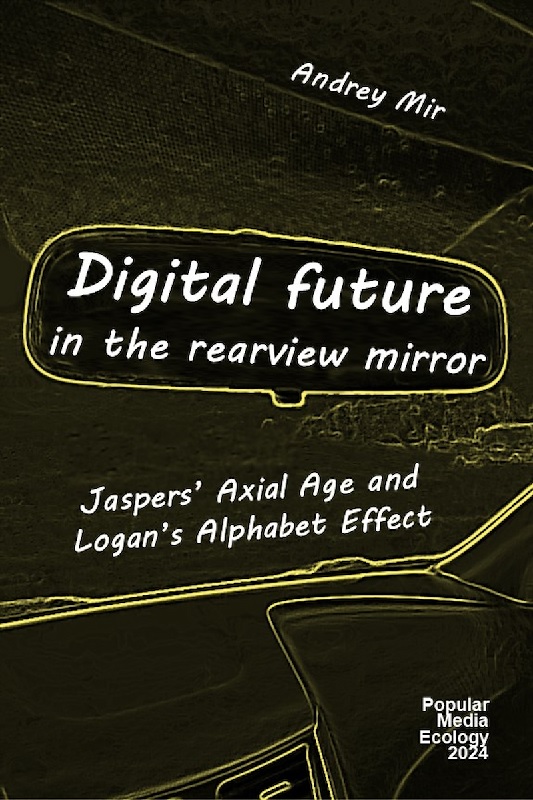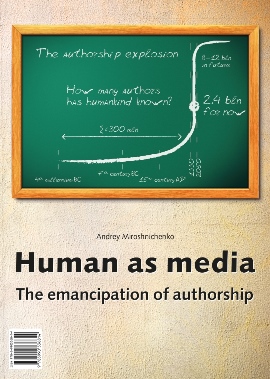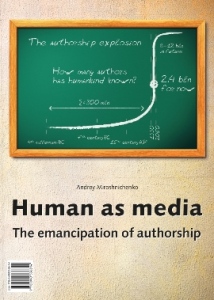The first “Artificial Intelligence” has emerged in the technological world, made up of real people: the Viral Editor of the Internet. It is currently building a new social reality, creating an alternative form of guerrilla journalism and begetting a new social contract. This collective being is in full opposition to the crowd and is an enemy of the state.
1. Physiology of the Viral Editor
1.1. The Viral Editor is a distributed being of the Internet, a sort of Artificial Intelligence whose “processing chips” are the people – users.
1.2. Identifying something of interest, a random user passes this information through his personal interests filter, conducts his own microediting and publishes his message, and he does so without any restrictions.
1.3. This is the same work that a professional editor is doing.
1.4. The user’s main goal is to elicit a response. This personal yearning for a response is the motivation behind the entire system. While weak on the individual, “atomic” level, for large arrays of users this motivation creates strong forces that nourish the Viral Editor’s work.
1.4.1. This is why it works – without money and without management – and why it does so much better than if it were driven by money or by commands.
1.5. If a user succeeds in being interesting, he will infect those who come into contact with him with interest in this subject. They in turn do the same; they try to contaminate others for the sake of response. If enough people are infected, it starts an epidemic of interest in a particular subject. This is what makes it viral.
1.5.1. The Viral Editor enables not only the transmission but also the crystallization of meaning, which is more important for the infected population, as well as the selection of the very best wording. This is what makes it an editor.
1.6. As a result of these adjustments, the “interest virus” mutates, striving to find the optimum form that allows it to contaminate as many “victims” as possible.
1.7. The Viral Editor always has a second message, which is contained not in the content, but in the range of the infection spread. If the viral message is redundant (everyone repeats the same piece of content), then this redundancy itself becomes the message.
1.7.1. The range and/or speed of infection tell us about the virus’s strength, that is, the importance of the subject.
1.8. The microediting epidemic generates social significance on a community or society-wide scale directly and without intermediaries, without the media.
2. The neurophysiology of the Viral Editor
2.1. The Viral Editor in its action resembles a neural network.
2.2. Reacting to excitation, a person’s brain forms differently sized neuron clusters to process thoughts. The behaviour of the Viral Editor is similar, spontaneously putting together clusters of “neuron-users” on important public issues. Every thematic stimulus in a chain of bloggers is a “thought” of digital society.
2.3. The fundamental difference between the Viral Editor and the brain is that the Viral Editor is capable of capturing his own historical states, which make up his unique, archival memory, and this memory is accessible at any point in time and from any point in time.
3. The Viral Editor improves people
3.1 A person’s behaviour in the Viral Editor is the direct inverse of a person’s behaviour in the crowd.
3.1.1. The crowd unleashes the herd instinct in man, destroying any sense of individuality. In the Viral Editor, on the contrary, the user wants a response specific to his individuality: to his assessment, his opinion.
3.2. In allowing a message to pass through his editing process, a person makes a judgment before his imagined and desirable audience. Participants in the Viral Editor necessarily cultivate their individuality, but within its socially approved boundaries, because they want a response from others.
3.3. The Viral Editor is a new form of positive socialization of individuals.
3.4. In marginal cases, users can achieve a response via perverse behaviour. In general, however, the majority of people strive to conform to the criteria approved by the majority.
3.5. This doesn’t mean that every person in the Viral Editor is good. It simply means that the average person in the Viral Editor is better, because he or she exposes him/herself to judgement by the others for the sake of a response.
3.6. In any case, the initial quality of the human material influences the end quality of the viral editing process.
4. The Viral Editor improves himself
4.1. In order to take part in the viral editing, users must be able to perform a wide range of complex intellectual operations. They should be able to: a) read, b) understand, c) evaluate, d) write, e) invest some of their own passion (if nothing else, by the very fact of their reposting).
4.1.2. Thus, even at the entry point to the system, the Viral Editor “checks” the participant’s personal access to a particular subject. A person with deficient qualities will not be able to join in the viral editing of a particular subject.
4.2. Having joined in the viral editing, the average person activates his socialization mode, and judges based on socially approved criteria, not merely improving himself, but thereby improving the overall quality of the viral editing.
4.3. The Viral Editor is pure freedom of personal reaction. Otherwise, it does not work. Solicited, made-to-order, commissioned reactions are possible, but on the statistical scale, they are revealed and inevitably destroyed by the prevailing numbers of free reactions.
4.3.1. Trojan messages in the Viral Editor fade away on their own or are loudly unmasked. The Viral Editor has a built-in self-cleaning tool.
4.3.2. If a lie is significant, it will circulate until it reaches witnesses and experts who will denounce it because they know the truth. If a lie is insignificant, no one will denounce it; but it won’t circulate.
4.3.3. Every example of a lie on the Internet, actually, is an example of disclosure of this lie.
4.4. The more Trojan messages become marketing and political in nature, the more aggressive the Viral Editor’s immunity is to them.
4.5. Marginal opinions are levelled out by the mainstream opinions. If they aren’t levelled out, they are not marginal.
4.6. The practical consequence of points 3 and 4 is as follows: the Viral Editor unavoidably works to increase the moral and intellectual quality of subjects being discussed on the Internet (in comparison with the crowd or rumours).
5. The Viral Editor is killing the reporter
5.1. Bloggers are scattered across the surface of the globe. At the same time, the concentration of bloggers can be found precisely where socially significant events take place most frequently and are most actively consumed.
5.1.1. The Viral Editor has his own correspondents wherever something might happen.
5.2. Any private or social event can be described by a blogger, can become the focus of attention of the Viral Editor and can be raised to the level of social significance.
5.3. The Viral Editor’s “staff reporters” are not only everywhere, they are also there instantly. An important event will be written about by a blogger before a professional reporter manages to get there, because some blogger is always already there.
5.4. Consequently, even the mass media use blogger reports rather than journalistic articles increasingly often. Journalism has been deprived of its monopoly over the news. The profession of the reporter is doomed.
6. The guerrilla journalism of the Viral Editor
6.1. The Viral Editor can provide a collective review on any issue and at any level of quality.
6.1.1. Some bloggers have a civic conscience. Often such bloggers receive high traffic. For the sake of the best response, these bloggers are focused on looking for, covering and analyzing socially important issues in which they are sufficiently competent.
6.1.2. If a subject is important, the Viral Editor calls on interested users, among them experts on the subject, to get involved in the discussion. The Viral Editor possesses all kinds of knowledge, both in terms of reach and depth. It can involve eyewitnesses and experts of any kind and any level of competence.
6.1.3. Participants in the discussion examine the subject from different perspectives and share all possible opinions, including valuable ones.
6.1.4. Even those participants who simply make noise (and these always make up the overwhelming majority) are useful to the Viral Editor, because they sustain the pace of thematic infection.
6.1.5. The most valuable testimonies and judgments are sublimated by their frequency, dressed up in the most striking phrases and instantly circulated by the participants themselves. This is how “guerrilla” (or civil) journalism is born.
6.2. A review involving this quantity and quality of experts, eyewitnesses and other volunteers is impossible in traditional mass media.
6.3. As a result, journalism is deprived of its monopoly over analysis and opinion. Thousands of journalists lose out to millions of bloggers not only in terms of reach, but also in terms of competence, style and wit.
6.4. The Viral Editor selects information after, rather than before, publication. Old media filter out the noise during publication, while the Viral Editor does so in the delivery process.
6.4.1. The Viral Editor captures the entire content of the Internet, but only selects what is of interest, delivering it only to those who will be interested. This is how the Viral Editor converts a vast pile of rubbish into a valuable product.
6.4.2. The Viral Editor’s guerrilla journalism, therefore, covers all subjects with 100% range, reaching its audience with 100% accuracy.
6.5. What may be a hard investigation in journalism is routine entertainment for the Viral Editor.
7. The Viral Editor is a supplier of free content
7.1. The Viral Editor relies on the physical and thematic ubiquity of bloggers, and due to their vast number, they accidentally but inevitably develop many topics, including significant ones.
7.2. The Viral Editor extracts, selects and distributes significant information for free.
7.2.1. The Viral Editor has at his disposal an enormous quantity of man-hours. For the sake of recognition and self-expression, millions of bloggers are constantly searching for significant subjects, events, discussions, expressions.
7.2.2. This is why the Viral Editor is capable of discovering everything. Significant matters, if they are significant, are sublimated and become the focus of social attention.
7.3. What journalists do on purpose, the Viral Editor does by chance, but it certainly and inevitably does it.
7.4. The Viral Editor cannot miss an important subject. If a subject is not picked up by the Viral Editor, either it is not socially significant or it hasn’t yet been discovered by the Viral Editor’s “staff reporters.”
7.4.1. Subjects not picked up by the Viral Editor or that have not crossed the epidemic threshold are what make up the noise of the Internet. The noise always predominates, but thanks to the mechanism of sublimation of significance built into the Viral Editor, it can eliminate noise, not from the Internet as a whole but from consumption.
7.5. Thanks to the Viral Editor the user cannot miss socially significant information. It will reach the user one way or another.
7.5.1. As a result, socially significant information on the Internet occurs and circulates of its own accord. One does not need to look for it or pay for it, as in the time of journalistic monopoly.
7.5.2. It is now not the reader who wants the message, but the message that wants the reader.
7.6. In the future, content will be paid for not by those who wish to consume it, but by those who wish to distribute it.
7.6.1. We are already paying for the right to be the media – paying with money, time, knowledge and passion.
7.7. The work of the Viral Editor is one of the main reasons behind free content for consumers. (Another reason is the increasing activity of information suppliers.)
7.7.1. The media’s attempts to sell content on the Internet using subscriptions have no future. It is possible to continue, but too late to begin.
8. The Viral Editor has no will
8.1. The Viral Editor is nothing more than a necessary side effect of the viral distribution of messages through a network of filters that change it. The Viral Editor has no goals of its own.
8.2. Freedom of personal reactions is one of the sources of the Viral Editor.
8.3. The will of the Viral Editor’s participants does not add up to a general will. The Viral Editor does not have a will. Its only “will” is the will to be. This will is focused on nothing more than its own existence.
8.4. The Viral Editor does not ask for approval. Nothing is prohibited for the Viral Editor. The Viral Editor has no centre or headquarters.
8.5. The Viral Editor has no location. The Viral Editor does not belong to anyone.
9. The Viral Editor is reactive
9.1. By having neither a will nor a centre, the Viral Editor has no identity.
9.1.2. Therefore the Viral Editor’s reactions are vegetative. The Viral Editor only reacts to what happens.
9.2. The Viral Editor is reactive, while the human editor is proactive.
10. The Viral Editor does not see the future
10.1. If an event has not yet happened, the Viral Editor has nothing to react to. The Viral Editor does not exist if nothing has happened yet. It does not have a function to predict events for the sake of discussing them, because it does not have any will. The Viral Editor is nonexistent with regard to the future.
11. The Viral Editor has taken everything away from the mass media except for navigation of the future and the panoramic agenda
11.1. The Viral Editor has destroyed the mass media’s monopoly over the production of news, analysis, opinions and also over information circulation. The Viral Editor has taken away the mass media’s monopoly over the production of benchmarks, having learned to develop a social significance no worse (or sometimes even better) than professional editorial offices.
11.2. The mass media are left with only two functions that the Viral Editor is unable to stifle. They navigate the future and compress a picture of the world into the panoramic agenda.
11.3. Navigation of the future falls under the competence of a person rather than that of the Viral Editor.
11.3.1. The future demands will. It is impregnable for the Viral Editor, but can be accessed by the human editor.
11.3.2. Relinquishing the past and the present to the Viral Editor, journalism can be preserved by focusing on the future, utilizing its advantage: the will of the human editor.
11.3.3. The drawing-up of reference points on the map of the future is the best kind of social navigation, because with time speeding up, no one needs to navigate the past or present (the “now” becomes the “past” too quickly).
11.4. The panoramic agenda is also an exclusive area of competence of the media editor, but not of the Viral Editor.
11.4.1. The Viral Editor extracts what is essential, interesting and significant, but it is not capable of giving the full, summarised picture of the Zeitgeist. In order to see the full picture of the world in the blogosphere, it is necessary to read the entire blogosphere. In the mass media, it is sufficient to leaf through a magazine or newspaper, or just have a look at the news.
11.4.2. The mass media compress the big picture of the world into an agenda consisting of a compacted horizon using a simple template: Politics/Economics/Culture/Society/ /Sport. The mass media editor fills out each section, even if the events are not top-rated. Filling out each section of the template is compulsory – and it is one of the remaining unique advantages of the mass media.
11.5. The professional compression of the picture of the world into a panoramic agenda, along with navigation of the future, are the two remaining mass media functions that make the work of investors, publishers and editors still worthwhile.
11.6. In contrast to the human editor, the Viral Editor does not produce a completed product. Aggregators partly fulfill this function; this is one of the niches for new media.
12. The Viral Editor is a new form of social contract
12.1. The selection and sharing of messages is a way of voting for the significance of these messages (with the possibility of “improving” the voting bulletin directly in the voting booth).
12.1.1. Reposts are the simplest and most accessible means of civil activity.
12.2. The turnout in the Viral Editor is accidental but 100% representative. Topical epidemics in the Viral Editor serve as referendums, as instant forms of direct democracy.
12.3. The opinion of the majority in the Viral Editor is not necessary for fulfillment, but it generates levels of social gravitation that can influence reality.
12.4. The Viral Editor is a mechanism of a virtual social contract – a self-built consensus of the masses regarding the key questions of social life.
12.4.1. The Viral Editor does not deal with politics. It deals with everything, including unbridled nonsense. But the most important topics in the Viral Editor relate to socially important issues, because social issues promise the user the largest response.
12.5. If the authorities do not allow a variety of opinions in politics, then these opinions are expelled to the Internet, which is an environment of free reactions, and they galvanize it. Repressed opinions have higher charge and are absorbed by the Viral Editor much better than an average opinion. This is why the Viral Editor tends to radicalize people in closed societies.
12.5.1. Under such conditions, the Viral Editor inevitably stands in opposition to the authorities (even bearing in mind the notable participation of pro-state activists in the Viral Editor – be they voluntary or paid).
12.6. The long-term co-existence of the Viral Editor and undemocratic power in the same human environment is impossible. The Viral Editor’s free sublimation of significance sooner or later takes people away from the government if the government does not give them enough freedom for self-expression. When enough users are drawn in, the Viral Editor unavoidably destroys the undemocratic power that wants to guide and rule these people.
12.6.1. This does not mean that the Viral Editor is able to build something to replace what it opposes.
Andrey Mir
Extracted from: Human as media. The emancipation of authorship
Available on Amazon now.
The Manifesto of the Viral Editor was published in Russian for the first time in Chastnyi Correspondent on December 17, 2010.
The concept of the Viral Editor was described for the first time in the series of columns in Slon.ru in November 2009.
See also: The Viral Inquisitor. Social media have unleashed a culture of instant judging. City Journal, Spring 2023.
See also books by Andrey Mir:
- Digital Future in the Rearview Mirror: Jaspers’ Axial Age and Logan’s Alphabet Effect (2024)
- Postjournalism and the death of newspapers. The media after Trump: manufacturing anger and polarization (2020)
- Human as media. The emancipation of authorship (2014)



Categories: Emancipation of Authorship, Future of journalism, Human as media book, Media ecology, Viral Editor

Leave a comment